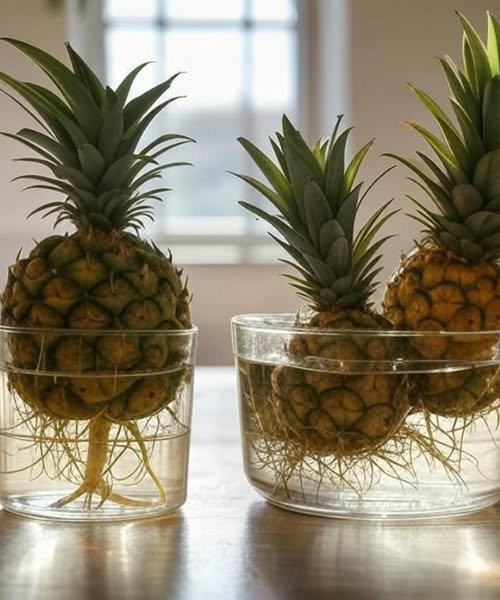Pineapples: The Sweet Indoor Gardening Surprise
Are you a fan of the tropical sweetness of pineapples? Imagine growing them right in your home! Beyond their flavorful fruit, pineapple plants can be an intriguing addition to your indoor plant collection due to their distinctive appearance.
Nurturing pineapples indoors is not just an enjoyable hobby but a fulfilling one, especially when you witness a pineapple crown evolving into a stunning plant that might even reward you with fruit. Here’s a guide to kickstart your indoor pineapple gardening journey.
Understanding the Pineapple Plant
Belonging to the Bromeliad family, which is home to several indoor decorative plants, pineapples (Ananas comosus) stand out with their perennial nature. Typically growing between 3-5 feet in height and spreading 3-4 feet wide, their elongated, blade-like leaves form a rosette pattern. In the heart of this rosette, you’ll find the single fruit-bearing stem.
A notable aspect of the pineapple plant is its suckers or slips, which sprout from its sides. These offshoots are valuable as they can be cultivated into new plants. Since a pineapple rosette yields fruit only once, these side shoots offer the chance for successive fruiting.
Initiating Your Pineapple Plant Journey
From the Crown of a Store-bought Pineapple:
1. Pick a Healthy Pineapple:
Go for one with firm green leaves, showing no signs of decay or disease. Aim for a slightly ripe fruit with robust leaves.
2. Detach the Crown:
Slice off the top about half an inch beneath the leaves. Clean any leftover fruit and allow it to air dry for a day to avoid rot.
3. Reveal the Stem:
Shed some of the bottom leaves to expose the stem which will grow roots.
4. Root Formation:
Submerge the revealed stem in water without wetting the leaves, changing water periodically. Alternatively, root it directly in a pot filled with aerated soil.
5. Planting:
Once roots extend to about 2-3 inches, settle the crown in a pot ensuring the leaf base is just above the ground.
Using a Sucker or Slip:
If you’re a proud owner of an existing pineapple plant, new ones can be propagated from the side sprouts.
- Detach the Sucker or Slip: Twist or cut it away carefully.
- Dry it Out: Allow the freshly cut end to air dry for a couple of days.
- Planting: Nestle it in a pot, keeping the leaf base slightly above the ground, and water generously.
Nurturing Your Indoor Pineapple
Soil and Potting:
Pineapples thrive in aerated soil. Opt for a succulent or cactus mix, or create one with equal parts potting soil, perlite, and sand. Ensure the pot, roughly 6-8 inches across, has efficient drainage.
Lighting Needs:
They adore bright light, so a sunny window spot or artificial grow lights are ideal.
Watering Regime:
Being resilient to dry spells, pineapples prefer sporadic deep watering. Ensure the soil’s top layer dries out before the next watering.
Climate and Moisture:
Ideal temperatures range between 65-85°F (18-30°C). A humid environment is preferred, so consider misting or using a humidifier in drier climates.
Nutrition:
During its growth phase (typically spring and summer), feed it with diluted balanced fertilizer every month or so.
Pruning:
Mostly hassle-free, just snip off any withered or unhealthy leaves when necessary.
Fruit Development:
Plants grown from crowns might take about 2-3 years to bear fruit, while those from suckers could fruit within a year or two. After flowering, the fruit ripens in around 6 months.
Challenges and Remedies:
- Root Rot:
- Ensure efficient drainage and moderate watering. If you notice signs, inspect and trim decayed roots and repot.
- Mealybugs and Scale:
These pests can be dealt with by wiping the plant with soapy water or rubbing alcohol.
Final Thoughts
Embracing the challenge of indoor pineapple cultivation offers both aesthetic pleasure and a tasty reward. By giving your plant ample light, the right soil, and the necessary care, you’ll be on your way to enjoying this tropical delight right from your living room!



